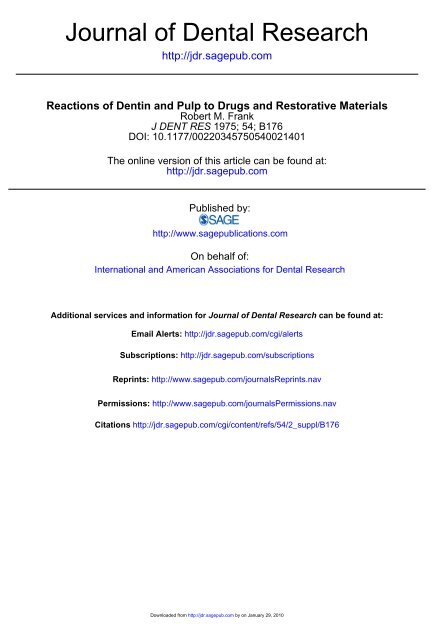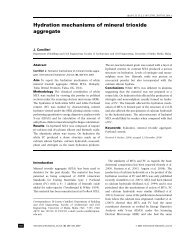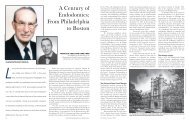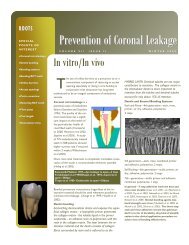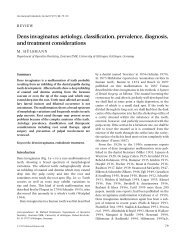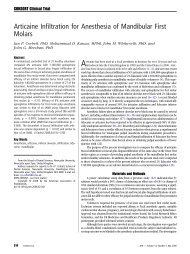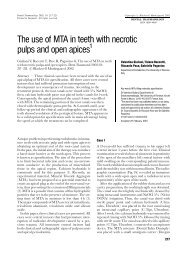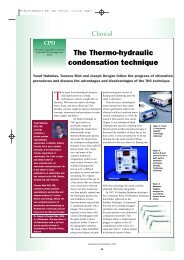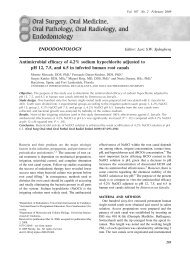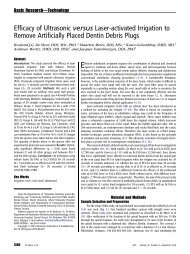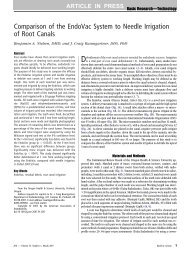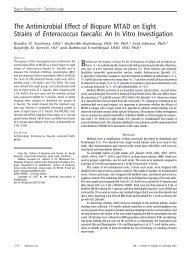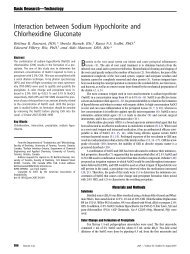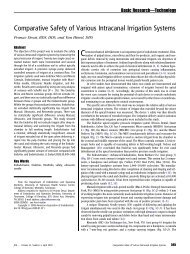Journal of Dental Research - The EndoExperience
Journal of Dental Research - The EndoExperience
Journal of Dental Research - The EndoExperience
Create successful ePaper yourself
Turn your PDF publications into a flip-book with our unique Google optimized e-Paper software.
<strong>Journal</strong> <strong>of</strong> <strong>Dental</strong> <strong>Research</strong><br />
http://jdr.sagepub.com<br />
Reactions <strong>of</strong> Dentin and Pulp to Drugs and Restorative Materials<br />
Robert M. Frank<br />
J DENT RES 1975; 54; B176<br />
DOI: 10.1177/00220345750540021401<br />
<strong>The</strong> online version <strong>of</strong> this article can be found at:<br />
http://jdr.sagepub.com<br />
Published by:<br />
http://www.sagepublications.com<br />
On behalf <strong>of</strong>:<br />
International and American Associations for <strong>Dental</strong> <strong>Research</strong><br />
Additional services and information for <strong>Journal</strong> <strong>of</strong> <strong>Dental</strong> <strong>Research</strong> can be found at:<br />
Email Alerts: http://jdr.sagepub.com/cgi/alerts<br />
Subscriptions: http://jdr.sagepub.com/subscriptions<br />
Reprints: http://www.sagepub.com/journalsReprints.nav<br />
Permissions: http://www.sagepub.com/journalsPermissions.nav<br />
Citations http://jdr.sagepub.com/cgi/content/refs/54/2_suppl/B176<br />
Downloaded from<br />
http://jdr.sagepub.com by on January 29, 2010
DENTIN-PULP<br />
H. R. MUHLEMANN, moderator<br />
Downloaded from<br />
http://jdr.sagepub.com by on January 29, 2010
Reactions <strong>of</strong> Dentin and Pulp to Drugs and<br />
Restorative Materials<br />
ROBERT M. FRANK<br />
<strong>Research</strong> Center, Faculty <strong>of</strong> <strong>Dental</strong> Surgery, Strasbourg, France<br />
<strong>The</strong> reactions <strong>of</strong> dentin and pulp to drugs<br />
and restorative materials are mainly the consequence<br />
<strong>of</strong> the tissue destruction induced<br />
by dental caries. Through improvements<br />
in technology, many new products are developed<br />
in dentistry and it is essential to<br />
know precisely their behavior toward the<br />
dental tissues. Hundreds <strong>of</strong> papers have<br />
been devoted to the biological testing <strong>of</strong><br />
drugs, liners, varnishes, bases, and fillings.<br />
Precise methodological rules have been recommended<br />
for their experimental evaluation.<br />
In addition to the study <strong>of</strong> the pulp,<br />
attention has been focused, in recent years,<br />
on the reaction <strong>of</strong> the inorganic part as well<br />
as <strong>of</strong> the cytoplasmic and organic components<br />
<strong>of</strong> dentin.<br />
Structure <strong>of</strong> Normal Pulp and Dentin<br />
<strong>The</strong> prominent pulpal cells are the fibroblasts<br />
and the fibrocytes. Great variations<br />
in cell density can be observed. <strong>The</strong> fibroblasts<br />
are slender bipolar cells containing a<br />
well-differentiated Golgi complex and endoplasmic<br />
reticulum closely associated with mitochondria.1<br />
<strong>The</strong> fibrocyte is characterized<br />
by a scarcity <strong>of</strong> organelles. Besides these<br />
prominent cell types, normal human pulp<br />
contains only a few macrophages, plasmocytes,<br />
mast cells, and leukocytes.<br />
<strong>The</strong> intercellular substance filled with<br />
ground substance contains two types <strong>of</strong><br />
fibrous elements. Collagen fibrils are disseminated<br />
as discrete bundles within the<br />
ground substance. With increasing age, collagen<br />
fibrils become more prominent. Besides<br />
the collagen, small nonstriated filaments,<br />
150 A in diameter, sometimes grouped<br />
in bundles, are considered to be similar to<br />
the so-called oxytalan fibrils <strong>of</strong> the periodontal<br />
membrane.',2<br />
<strong>The</strong> blood vessels <strong>of</strong> the pulp consist<br />
B176<br />
Downloaded from<br />
http://jdr.sagepub.com by on January 29, 2010<br />
mainly <strong>of</strong> numerous capillaries connected<br />
with arterioles and venules. Many neural<br />
elements follow the pathways <strong>of</strong> the larger<br />
vessels which have a thin layer <strong>of</strong> muscle<br />
cells surrounding the endothelium-lined<br />
tubes. Two types <strong>of</strong> blood capillaries are<br />
located in the dental pulp. Capillaries with<br />
continuous thick or thin endothielial lining<br />
are surrounded by a basement membrane<br />
and crowns <strong>of</strong> pericytes. <strong>The</strong>y were seen<br />
alternating with fenestrated capillaries.'<br />
<strong>The</strong>se have thin endothelial cells and show<br />
numerous pores about 600 A in diameter<br />
and were found in regions where important<br />
and fast liquid exchanges occur. <strong>The</strong>se<br />
fenestrated capillaries contribute to a faster<br />
control <strong>of</strong> hydremia and electrolyte balance<br />
between the intravascular compartment and<br />
the interstitial tissue. Riedel, Fromme, and<br />
Tallen3 and Kukletova4 have claimed to<br />
have identified lymphatic capillaries in the<br />
pulp under the electron microscope. Such<br />
lymphatic capillaries had open walls witlh<br />
their vessel lumens communicating directly<br />
with the surrounding connective tissue.<br />
<strong>The</strong> subodontoblastic layer is classically<br />
constituted by the acellular Weil's zone, located<br />
along the odontoblasts, and a cell-rich<br />
layer described by Gotjamanos.5 However,<br />
the acellular zone can be absent in normal<br />
adult pulps and a cell-rich layer is then<br />
interposed between the odontoblasts and the<br />
pulpal tissue.1<br />
All nerve fibrils penetrating in the pulp<br />
through the apical region are surrounded by<br />
Schwann cells. <strong>The</strong> myelinated nerve fibrils<br />
have a rounded or folded myelin sheath.'<br />
<strong>The</strong> myelin sheath surrounds the axon. A<br />
basement membrane, located on the external<br />
cell membrane <strong>of</strong> the Schwann cell, limits<br />
the myelinated fiber.<br />
Several amyelinated nerve fibrils are in
Vo 1 54 1975<br />
vaginated within the cytoplasm <strong>of</strong> a Schwann<br />
cell. <strong>The</strong> plasma membrane <strong>of</strong> this latter<br />
cell constitutes typical mesaxons. A basement<br />
membrane is seen around the amyelinated<br />
nerve fibrils, which are more numerous near<br />
the subodontoblastic layer <strong>of</strong> the pulp chamber.<br />
In the plexus <strong>of</strong> Raschkow, both types<br />
<strong>of</strong> nerve fibers can be seen loosing their<br />
Schwann cell covering and their basement<br />
membrane, and close contacts between fibroblasts<br />
and odontoblasts have been observed.0<br />
Myelinated fibers can also loose their myelin<br />
sheaths.6 In the coronal dentin, some nerve<br />
fibers pass between the odontoblasts and<br />
reach the predentin and inner dentin.<br />
<strong>The</strong> odontoblasts in normal adult dentin<br />
may have different ultrastructural aspects.<br />
When engaged in secretory activities, the<br />
cell has a well-developed Golgi zone located<br />
along the dentinal side <strong>of</strong> the nucleus<br />
with different types <strong>of</strong> vesicles, vacuoles, and<br />
elongated and multivesicular bodies. This<br />
Golgi zone is surrounded by a rich endoplasmic<br />
reticulum with numerous mitochondria<br />
containing dense calcium granules.<br />
Micr<strong>of</strong>ilaments and microtubules are disseminated<br />
in the cytoplasm. When engaged<br />
in catabolic activities, large lysosomelike<br />
structures are visible within the odontoblast<br />
which can also take the aspect <strong>of</strong> a resting<br />
cell with just a few organelles. <strong>The</strong> lateral<br />
surfaces <strong>of</strong> these cells are connected by desmosomes,<br />
whereas toward the predentin these<br />
surfaces are attached by a junctional complex<br />
consisting <strong>of</strong> a desmosome, an intermediary<br />
junction, and a tight junction located<br />
near the predentin. In tile lateral<br />
intercellular spaces, some collagen bundles<br />
as well as some nerve fibers can be observed.<br />
<strong>The</strong> odontoblast process, a cellular extension<br />
<strong>of</strong> the odontoblast, extends through<br />
predentin and dentin. Brannstrom and<br />
Garberoglio,7 through use <strong>of</strong> a scanning electron<br />
microscope, observed that these processes<br />
in young human premolars were only<br />
found within a distance from the pulp equaling<br />
about one-quarter <strong>of</strong> the total length <strong>of</strong><br />
the tubule. With transmitted electron microscopy,8<br />
most <strong>of</strong> the dentinal tubules near the<br />
human dentinoenamel junction showed absence<br />
<strong>of</strong> odontoblastic processes; however, in<br />
young human premolars, hyaline peripheral<br />
degenerescence <strong>of</strong> these processes was observed.<br />
Bound by a plasma membrane, the cyto-<br />
Downloaded from<br />
http://jdr.sagepub.com by on January 29, 2010<br />
DENTIN AND PULP REACTIONS B177<br />
plasmic process at the level <strong>of</strong> predentin<br />
and inner dentin contains numerous microtubules<br />
and micr<strong>of</strong>ilaments with few organelles.<br />
Elongated small granules, associated<br />
with transfer <strong>of</strong> collagen9'10 and ground substance<br />
precursors"l during dentinogenesis,<br />
are rarely seen in adult dentin. In the latter,<br />
large vacuoles with light or dense contents,<br />
which seem to be associated either with<br />
exocytosis or endocytosis,12 are observed at<br />
different levels <strong>of</strong> the odontoblast and its<br />
process. At the peripheral extremity <strong>of</strong> the<br />
process, centrally located large vacuoles, with<br />
light cores, are associated with a hyaline<br />
cytoplasmic degenerescence <strong>of</strong> the process.13<br />
Lateral cytoplasmic processes penetrate in<br />
lateral b)ranching <strong>of</strong> the tubule.<br />
<strong>The</strong> odontoblast process does not fill the<br />
tubular lumen and between the odontoblast<br />
process and the calcified wall <strong>of</strong> the tubule,<br />
a periodontoblastic space is visible.'3 In<br />
the inner dentin, it contains a few uncalcified<br />
collagen bundles in areas where the<br />
tubular walls are made up by intertubular<br />
dentin. In addition, this space as well as the<br />
peripheral lumen <strong>of</strong> the tubules devoided<br />
<strong>of</strong> odontoblast process (dead tracts) are filled<br />
with the so-called dentinal fluid,14 which<br />
lhas the composition <strong>of</strong> interstitial fluid.15"16<br />
<strong>The</strong> odontoblast process is suspended in this<br />
fluid phase.<br />
At a certain distance from the predentindentin<br />
border, the wall <strong>of</strong> the dentinal<br />
tubule is made up <strong>of</strong> hypercalcified peritubular<br />
dentin, which, in comparison to intertubular<br />
dentin, contains more minerals,<br />
fewer collagen fibrils, and more ground substance.<br />
Even in normal conditions, the<br />
dentinal lumen can be completely occluded<br />
by apatitic mineralization.9 This dentinal<br />
sclerosis, also observed in transparent dentin<br />
during the carious process,17 also can occur,<br />
in this latter case through deposition <strong>of</strong><br />
rhombohedral crystals consisting <strong>of</strong> PCa3-<br />
(P04) 2 whitlockite.18 It is important to<br />
note that in an area <strong>of</strong> dentinal sclerosis, all<br />
tubules are not occluded and some scattered<br />
lumens remain permeable.17<br />
In recent years, important progress has<br />
been made in the understanding <strong>of</strong> the morphological<br />
basis <strong>of</strong> dental innervation. <strong>The</strong><br />
most convincing evidence for dentin innervation<br />
using light microscopy has been established<br />
by Fearnhead,19 and recently confirmed<br />
by Kerebel20 and Langeland, Yagi,
B178 FRANK<br />
and Langeland.21 With the electron microscope,<br />
unmyelinated nerve fibers have been<br />
located in the inner third <strong>of</strong> fully formed<br />
coronal dentin in humans,'.7,'3.22,23,26 in<br />
mice,24 white rabbits,25 cats,6 and fish.6<br />
Presence <strong>of</strong> complex tight junctions between<br />
the nerve fiber and the odontoblast process,<br />
with many attributes <strong>of</strong> synaptic or transducer<br />
sites, has been described.23,26 In addition,<br />
unmyelinated axons surrounded by<br />
Schwann cells23,24 and myelinated fibers23<br />
have been observed in tubules <strong>of</strong> inner<br />
dentin.<br />
Controversial data have been obtained<br />
from electrophysiological investigations concerning<br />
the presence <strong>of</strong> intradentinal receptors.27<br />
Scott28 recorded electrical activity<br />
which according to him originated in the<br />
inner dentin <strong>of</strong> cat canines. However,<br />
Matthews29 thought that the recorded activity<br />
was conducted through the dentin<br />
from nerves located in the underlying pulp<br />
<strong>of</strong> the cat. In fact, conclusive evidence has<br />
now been presented about the intradentinal<br />
presence <strong>of</strong> sensitive neurons. With the<br />
light microscope Christensen30 showed that<br />
nearly all nerve fibers in the pulp disappeared<br />
after sectioning <strong>of</strong> the fifth nerve in<br />
the cat but removal <strong>of</strong> the sympathetic superior<br />
cervical ganglion caused no appreciable<br />
change in the pulpal nerve distribution.<br />
Fearnhead,'9 after resection <strong>of</strong> the inferior<br />
dental nerve in a green monkey, observed<br />
in the light microscope, after one month,<br />
the disappearance <strong>of</strong> the plexus <strong>of</strong> Raschkow<br />
and the intradentinal beaded nerves. After<br />
resection <strong>of</strong> the inferior alveolar nerve, degenerescence<br />
or absence <strong>of</strong> the unmyelinated<br />
predentinal and dentinal nerve fibers was<br />
noted under the electron microscope in<br />
mice,30 white rabbits,25 and cats,3' together<br />
with a total absence <strong>of</strong> nervous activity after<br />
electrophysiological recordings.31<br />
Absence <strong>of</strong> nerves near the enamel-dentinal<br />
junction and the outer part <strong>of</strong> dentin<br />
is generally recognized,8,9,19,28 although<br />
these areas are known to be clinically highly<br />
sensitive. Strong evidence has been presented<br />
through numerous in vitro and in<br />
vivo experiments that transmission <strong>of</strong> pain<br />
stimuli to intradentinal and pulpal nerves<br />
are mediated through a hydrodynamic<br />
link.32,33 A rapid outward flow in the dentinal<br />
tubules can produce an immediate<br />
sharp pain that can be elicited by most<br />
Downloaded from<br />
http://jdr.sagepub.com by on January 29, 2010<br />
J Dent Res Special Issue B<br />
stimuli such as drilling, probing, air blasts,<br />
and cold.33 A second type <strong>of</strong> pain sensation<br />
is that which may be elicited by heat. <strong>The</strong><br />
required stimulus for this response is an extensive<br />
inward movement <strong>of</strong> the tubule<br />
contents.33<br />
Evaluating Dentin and Pulp Reactions<br />
to Drugs and Materials<br />
<strong>The</strong> evaluation <strong>of</strong> the dentin and pulpal<br />
reactions to drugs and materials is the final<br />
test required in the step-by-step procedure<br />
developed by the US Department <strong>of</strong> Health,<br />
Education, and Welfare.34 Such a biologic<br />
evaluation is quite difficult to aclhieve because<br />
<strong>of</strong> the great variability in the parameters<br />
involved and standardization <strong>of</strong> the experimental<br />
procedures appears as a necessity.35-37<br />
Generally speaking, the dental tissue reactions<br />
<strong>of</strong> new products are initially tested<br />
in animal teetlh, followed by experiments on<br />
human teeth. UJsually, intact teeth from rats,<br />
dogs, primates, and miniature pigs are used,<br />
but if healing properties <strong>of</strong> druigs or materials<br />
are to be tested, an experimental pulpitis<br />
system can be useful.38<br />
In human teeth, age differences seem to<br />
have no discernible effect on pulp response36;<br />
however, most authors preferably<br />
use noncarious human premolars <strong>of</strong> young<br />
patients, 12 to 15 years old, to be extracted<br />
for orthodontic purposes. Ideally, four premolars<br />
in one patient are tested in two<br />
crossed pairs; one tooth in each pair drawn<br />
by lots is filled with a control material. Usually<br />
one cavity is prepared in one tooth, but<br />
Mjor39 used buccal and lingual preparations<br />
to estimate the reaction on the same pulp.<br />
<strong>The</strong> methods <strong>of</strong> cavity preparation also must<br />
be standardized. Most authors prepare buccal<br />
Class V cavities with low speeds and<br />
abundant cooling with water spray. An extremely<br />
critical factor in pulp response is<br />
the remaining dentin thiickness36 which cannot<br />
be controlled accurately during cavity<br />
preparation. <strong>The</strong> dentin thickness has to be<br />
measured on the histological sections.<br />
Important variables in assessments <strong>of</strong> dentin<br />
and pulp reactions are related to the histological<br />
technique used. Special care must<br />
be taken in the fixation, demineralization,<br />
and staining procedures. Serial sections<br />
have to be examined. In understanding dentin<br />
alterations, it must not be forgotten that
Vol1 54 1975<br />
peritubular dentin and sclerosed tubular<br />
lumen are dissolved during acid or ethylenediaminetetraacetic<br />
acid treatment. <strong>The</strong>refore,<br />
special techniques such as microradiography,<br />
transmitted and scanning electron<br />
microscopy, and electron microprobe analysis,<br />
may be indicated to study reactions in<br />
the dentinal tubules.<br />
Adequate differentiation must be made<br />
between normal histological variations,40 reaction<br />
caused by cavity preparation, and that<br />
caused by the drug or material itself. Different<br />
types <strong>of</strong> criteria have been used to<br />
estimate the severity <strong>of</strong> pulpal reactions to<br />
materials, which in most instances follow in<br />
fact a relatively uniform evolution. For example,<br />
Stanley36 used three histopathological<br />
characteristics based on odontoblast and<br />
leukocyte displacements in dentinal tubules,<br />
importance <strong>of</strong> the inflammatory cell infiltrate<br />
in the superficial and deeper pulpal<br />
tissue, and the predominating inflammatory<br />
cell. Holz and Baume4l paid special attention<br />
to the state <strong>of</strong> the odontoblast processes<br />
in the dentinal tubules <strong>of</strong> the cavity floor<br />
and based their study on four criteria consisting<br />
<strong>of</strong> odontoblast aspects, secondary dentin<br />
formation, pulpal degenerescence, and<br />
inflammatory response. In fact, almost every<br />
author used his own technique for the rating<br />
<strong>of</strong> pulpal reactions.<br />
In most experiments, postoperative periods<br />
<strong>of</strong> short and long durations have been<br />
used, but here again great variations are<br />
noted between different studies. Langeland37<br />
observed inflammatory changes at the pulpdentinal<br />
junction as early as three hours.<br />
Short-term experiments may give misleading<br />
results in that they do not allow adequate<br />
time for the recuperative powers <strong>of</strong> the<br />
dental pulp to reach their full expression.<br />
<strong>The</strong> great importance <strong>of</strong> long-term experiments<br />
must be emphasized. Following the<br />
repair <strong>of</strong> dental pulp after cavity preparation<br />
up to 21 months, Marsland and<br />
Shovelton42 noticed that repair occurred in<br />
the pulp with deposition <strong>of</strong> an important<br />
layer <strong>of</strong> secondary dentin by new odontoblasts<br />
differentiated from the less specialized<br />
cells <strong>of</strong> the pulp after destruction <strong>of</strong> the<br />
original odontoblast lining. We agree with<br />
these authors42 when they state that the condemnation<br />
<strong>of</strong> a filling material is not justified<br />
if it produces a localized pulpitis in a<br />
young, sound tooth after a few days. It will,<br />
Downloaded from<br />
http://jdr.sagepub.com by on January 29, 2010<br />
DENTIN AND PULP REACTIONS B179<br />
however, warrant rejection if it consistently<br />
produces important pulp lesions after 200<br />
days. One <strong>of</strong> the main pulpal functions is<br />
dentinogenesis; therefore, new formation <strong>of</strong><br />
dentin under a filling should be considered<br />
as biologically satisfactory. Several studies43,44<br />
using tritiated thymidine have<br />
shown that after initial odontoblast degenerescence,<br />
new odontoblasts can be differentiated<br />
from spindle-shaped cells <strong>of</strong> the<br />
pulp.<br />
If pulpal-dentinal lesions can result from<br />
the action <strong>of</strong> drugs or fillings, irritations<br />
through salivary or bacterial infiltrations<br />
along the cavity walls can also play an important<br />
role. Marginal leakage has been<br />
demonstrated through percolation and diffusion<br />
<strong>of</strong> different dyes or radioisotopes, as<br />
well as through observations with reflected<br />
light microscopy and scanning electron microscopy.<br />
Recently Brannstrom and Nyborg45<br />
have even assumed that diffusion <strong>of</strong><br />
bacteria trapped in cavity walls before restoration<br />
or entering through marginal leakage,<br />
rather than the chemical irritation by<br />
fillings, may be the main cause <strong>of</strong> pulpal inflammation.<br />
Accordingly, they recommend<br />
that the test and control cavities be cleaned<br />
with a microbicidal solution.45<br />
Dentin and Pulp Reactions to Drugs<br />
Most drugs and substances applied to dentin,<br />
with the possible exception <strong>of</strong> dilute<br />
adenocorticotropic hormone and cortisone<br />
derivatives, produce an inflammatory reaction<br />
within the pulp. All fat solvents such<br />
as ether, chlor<strong>of</strong>orm, xylol, and acetone produce<br />
severe reactions to odontoblasts and are<br />
most irritating.46 Some essential oils, such<br />
as eugenol, are if anything at least nonreactive.<br />
Phenol penetrates dentin easily and is<br />
highly irritative.46 Hydrogen peroxide applied<br />
to dentin caused an inflammatory reaction<br />
in intact pulp and did not reduce an<br />
existing inflammation.47<br />
Silver nitrate, <strong>of</strong>ten used as a cavity<br />
sterilization or desensitizing agent, is able to<br />
penetrate the dentinal tubules <strong>of</strong> primary<br />
and secondary dentin.47 Silver nitrate granules<br />
have been observed as early as five minutes<br />
after its use at a distance <strong>of</strong> 50 micrometers<br />
in the odontoblast process.41 A microbicidal<br />
cavity cleanera containing chlorhexidine<br />
and dodecyldiaminoethyl glycine in a<br />
a Tubulicid, <strong>Dental</strong> <strong>The</strong>rapeut. A.B., Nacka, Sweden.
B180 FRANK<br />
3% sodium fluoride solution, applied for<br />
five seconds after cavity preparation, was<br />
claimed to eliminate all bacteria remaining<br />
on the walls without an irritating pulpal<br />
effect.45<br />
Camphorated parachlorphenol, when applied<br />
to dentin, produced pulpal inflammation.47<br />
It could be shown that this drug as<br />
well as eugenol and Formocresol destroyed<br />
lysosome fractions prepared from bovine<br />
pulp.48 A radioautographic comparison <strong>of</strong><br />
the dentin penetration <strong>of</strong> tritiated aqueous<br />
parachlorophenol and camphorated parachlorophenol<br />
placed in the pulp chamber<br />
and root canal showed that the first solution<br />
penetrated the dentin and reached the<br />
cementodentinal junction, whereas the camphorated<br />
parachlorphenol did not.49<br />
Topical fluoride solutions have been applied<br />
to freshly prepared dentin cavities for<br />
remineralization <strong>of</strong> carious tissue and for<br />
reduction <strong>of</strong> recurrent marginal caries. Remineralization<br />
was demonstrated in vitro<br />
with a 10% stannous fluoride solution50 as<br />
well as a reduction in acid solubility <strong>of</strong><br />
dentin treated with a 2% sodium fluoride<br />
solution.5' Stannous fluoride applied to<br />
freshly cut dentin or to the exposed pulp<br />
tissue produced no adverse effects in rats,52,53<br />
dogs,54 or primates.55 By diffusion <strong>of</strong> sodium<br />
fluoride, stannous fluoride, and acidulatedphosphate<br />
fluoride solutions through dentinal<br />
disks onto monolayers <strong>of</strong> marmoset gingival<br />
fibroblasts, no cytotoxic effects were<br />
noticed at clinically used concentrations and<br />
exposure times.56 No harmful effects on<br />
human pulps were observed after a 2% sodium<br />
fluoride treatment <strong>of</strong> experimentally<br />
prepared cavities for two minutes.57<br />
Cervical root hypersensitivity has been<br />
treated with sodium fluoride and other compounds<br />
containing fluoride. Microradiography<br />
and electron microscopic studies <strong>of</strong><br />
hypersensitive dentin with CaHPO4 showed<br />
mineral deposition and sclerosed dentinal<br />
tubules.58 Some workers have attempted to<br />
enhance chemical penetration by using iontophoresis.<br />
lontophoresis was effective when<br />
used either with or without a fluoride dentifrice,59<br />
but a placebo effect was demonstrated<br />
in the control group. A desensitizing<br />
effect also was observed with a calcium hydroxide<br />
paste.60<br />
Finally, it must not be forgotten that low<br />
Downloaded from<br />
http://jdr.sagepub.com by on January 29, 2010<br />
J Dent Res Special Issue B<br />
molecular weight medicaments commonly<br />
used in contact with viable pulp may serve<br />
as haptens. Immunologic sensitization<br />
through pulp canals in rabbits6i and primates62<br />
has been demonstrated.<br />
Pulp Capping Agents<br />
Numerous pulp capping agents hiave been<br />
used, but the ideal remedy has not been<br />
found. Calcium hydroxide preparations are<br />
most widely used but seem to have their<br />
limitations. Despite the opinion <strong>of</strong> Langeland<br />
and Langeland,63 convincing evidence<br />
indicates that calcium hydroxide will increase<br />
the density, hardness, and mineral<br />
content64,65 <strong>of</strong> underlying carious dentin in<br />
primary and permanent teeth. It sterilizes<br />
the residual deep layer <strong>of</strong> caries66 and produces<br />
secondary dentin deposition.67 With<br />
45Ca, it has been shown that calcium liydroxide<br />
did not participate directly in the<br />
formation <strong>of</strong> reparative dentin.68 In comparative<br />
studies, zinc oxide and eugenol<br />
(ZOE) was thought to be as effective as<br />
calcium hydroxide for covering residual caries.69,70<br />
However, no visible change could<br />
be demonstrated through microradiography<br />
in ZOE-covered dentin.65<br />
Different types <strong>of</strong> calcium hydroxide<br />
preparations are commercially available:<br />
Pulpdentb is suspended in methyl cellulose,<br />
whereas Hydrexc and Dycald contain resins.<br />
Controversial evaluation has been made <strong>of</strong><br />
these materials as base materials, especially<br />
under composites. Whereas Tronstad and<br />
Mjdr7l found all <strong>of</strong> these three products acceptable,<br />
Holz and Baume4l obtained unsatisfactory<br />
pulpal reactions with Pulpdent<br />
and Hydrex. This latter product gave good<br />
protection under a composite according to<br />
Langeland, Dogon, and Langeland.72 However,<br />
Sekine and others,73 testing different<br />
calcium hydroxide preparations, obtained<br />
the worst results with Hydex and the best<br />
with Calvital.e<br />
Direct pulp capping with calcium hydroxide<br />
on pulp exposures seemed to produce an<br />
irregular calcified bridge caused by calcification<br />
<strong>of</strong> collagen produced by fibroblasts<br />
followed by a regular dentin bridge.74.75<br />
However, Langeland37 cast some doubts on<br />
b Rower <strong>Dental</strong> Mfg. Corp., Boston, Mass.<br />
" Kerr Mfg. Co., Detroit, Mich.<br />
d L. D. Caulk Co., Milford, Del.<br />
e Neo Chemical Products Co., Japan.
Vol1 54 1975<br />
the quality <strong>of</strong> the dentin bridge formed and<br />
underlined the risk <strong>of</strong> residual chronic<br />
pulpal inflammation. Zinc oxide eugenol<br />
cement seemed to provide more favorable<br />
pulp healing than calcium hydroxide, but<br />
no complete dentin bridge formed.76 Clinical77<br />
and experimental78 studies apparently<br />
substantiated the efficacy <strong>of</strong> Dycal as a direct<br />
pulp capping agent, whereas in pulp exposures<br />
<strong>of</strong> intact rat molars Hydrex produced<br />
chronic inflammation and pulp necrosis.79<br />
In pulpotomies, after sterile amputation<br />
<strong>of</strong> the coronal pulp and calcium hydroxide<br />
application on the pulp stumps, Schroder<br />
and Granath80 observed that in young human<br />
premolars after one month a calcific<br />
barrier was formed first by an irregular bonelike<br />
substance while the last one resembled<br />
dentin. In primary teeth, after pulpotomy,<br />
dressings <strong>of</strong> calcium hydroxide or Formalincontaining<br />
compounds have been recommended.<br />
<strong>The</strong>y were evaluated in primary<br />
and young permanent teeth <strong>of</strong> rhesus monkeys.81<br />
It seemed that the Formocresol<br />
therapy gave results superior to the hydroxide<br />
pulp therapy. In incompletely formed<br />
pulpless teeth, the relationship <strong>of</strong> calcium<br />
hydroxide paste to continued root formation<br />
and absence <strong>of</strong> inflammatory response<br />
in the periapical tissues has been demonstrated<br />
in dogs.82<br />
Indirect pulp capping with antibiotics<br />
does not seem to be adequate: dentinal application<br />
<strong>of</strong> penicillin47 or association with<br />
camphorated paramonochlorphenol63 produced<br />
pulpal inflammation. Studies with<br />
conventional and germfree rats demonstrated<br />
that the presence <strong>of</strong> bacteria is a<br />
significant factor in prohibiting healing <strong>of</strong><br />
pulp exposures.83 <strong>The</strong> association <strong>of</strong> calcium<br />
hydroxide with vancomycinf as direct<br />
pulp capping agents was more successful<br />
than calcium hydroxide alone.84 However,<br />
the single use <strong>of</strong> sodium cephalothin"<br />
proved to be too irritating for vital pulp<br />
therapy.78<br />
Controversial results also have been obtained<br />
with corticosteroids used alone or associated<br />
with antibiotics. When corticosteroids<br />
were used for indirect pulp capping,<br />
suppression or reduction <strong>of</strong> pulpal inflammation<br />
without alteration <strong>of</strong> dentinogenesis<br />
f Vancocin, Eli Lilly Co., Indianapolis, Ind.<br />
g Keflin, Eli Lilly Co., Indianapolis, Ind.<br />
Downloaded from<br />
http://jdr.sagepub.com by on January 29, 2010<br />
DENTIN AND PULP REACTIONS B181<br />
was observed by most authors85-87; in direct<br />
pulp capping, persistent inflammation with<br />
increased dentinogenesis63 or the absence <strong>of</strong><br />
dentin formation87'88 was noted. In germfree<br />
animals,83 it is interesting to note that<br />
application <strong>of</strong> corticosteroids is neither helpful<br />
nor harmful to exposed pulp -healing.<br />
Most authors observed a persistent chronic<br />
inflammation <strong>of</strong> the pulp with a corticosteroid-antibiotic<br />
preparationh in direct pulp<br />
capping.63,87<br />
Preliminary results seemed to indicate that<br />
lyophylized89 or demineralized90 dentin<br />
could be better direct capping agents than<br />
calcium hydroxide, antibiotics, or corticosteroids.<br />
Base Cements, Liners, and Varnishes<br />
A combination <strong>of</strong> ZOE is still widely used<br />
for temporary fillings and protective bases<br />
under permanent fillings. It has been stated<br />
that ZOE, like zinc phosphate cement, can<br />
be irritating in deep cavities; nevertheless,<br />
most testing experiments <strong>of</strong> materials use<br />
ZOE as a control material.<br />
Since ZOE has low compressive strength,<br />
different additives have been proposed to<br />
reinforce the original formulation. IRMi<br />
(a resin-reinforced ZOE), EBA,j Kalsogen,k<br />
and Cazil seemed to be biologically acceptable<br />
but also slightly more irritative than<br />
ZOE.41 ,91<br />
It was thought that oxyphosphate cements<br />
and copper cements were damaging to the<br />
pulp. According to Langeland,37 this is<br />
seemingly true for copper cements, but not<br />
for oxyphosphate cements. It seemed that<br />
the reactions observed were due to overdrying<br />
<strong>of</strong> the cavity. Whereas Plant and Tyas92<br />
and Eriksen93 observed mild reaction with<br />
Dropsin,m a modified zinc phosphate, Holz<br />
and Baume4' consider this cement as improper<br />
for pulpal protection.<br />
<strong>The</strong> polycarboxylate cement system, first<br />
developed by Smith,94 consists <strong>of</strong> a modified<br />
zinc oxide powder and an aqueous solution<br />
<strong>of</strong> polyacrylic acid. Zinc phosphate and<br />
polycarboxylate cements appear to have<br />
similar properties especially in setting time<br />
h Ledermix, Lederle Arzneimittel, Cyanamid Gmbh,<br />
Munchen-Pasing, West Germany.<br />
I L. D. Caulk Co., Milford, Del.<br />
J Opotow <strong>Dental</strong> Mfg. Co., Brooklyn, NY.<br />
k De Trey, Zurich, Switzerland.<br />
National Bureau <strong>of</strong> Standards, Washington, DC.<br />
m Svedia, Enkoping, Sweden.
B182 FRANK<br />
and pH,92 but the latter cement seemed to<br />
have better biologic properties and bonding<br />
potentials. As a base material on dentin or<br />
as luting agents, almost all reports95-100<br />
have mentioned mild pulpal reactions with<br />
Durelon.n Only Holz and Baume4' reported<br />
dentin and pulp lesions and even pulp necrosis<br />
with Poly Co after 120 days.10'<br />
<strong>The</strong> intended effects <strong>of</strong> liners and varnishes<br />
are to protect the pulp from chemical<br />
irritants <strong>of</strong> the restorative materials, to prevent<br />
marginal leakage and ingress <strong>of</strong> bacteria,<br />
and to ensure thermal insulations. A<br />
cavity varnish is a natural gum such as<br />
copal, resin, and synthetic resin dissolved in<br />
an organic solvent, whereas a cavity liner is a<br />
liquid in which calcium hydroxide or zinc<br />
oxide or both are suspended in a solution <strong>of</strong><br />
natural or synthetic resins. Going and Massler102<br />
found that copal resin varnishes, polystyrene<br />
ethylcellulose liner, and calcium<br />
hydroxide liners were effective in preventing<br />
penetration <strong>of</strong> radioactive ions into the dentin<br />
and pulp. However, it must not be forgotten<br />
that in vivo dentin surfaces are<br />
wet'4-'6 and therefore the application <strong>of</strong><br />
liners or varnishes may not lead to impervious<br />
sheaths.37'103<br />
It was found that a vinyl copolymer linerP<br />
was not adequate to protect pulp under<br />
composite fillings.104'105 Whereas Holz and<br />
Baume4' noticed favorable reaction with<br />
cyanoacrylate liners under amalgam fillings,<br />
this was not the case under composites.<br />
However, in dogs, Tobias et al'06 found that<br />
this type <strong>of</strong> liner was well tolerated and<br />
Berkman et al,107 using isobutyl cyanoacrylate<br />
as direct pulp capping agents on human<br />
teeth, observed more even healing <strong>of</strong><br />
the pulp with reparative dentin bridge formation<br />
and less inflammation than with calcium<br />
hydroxide preparations.<br />
A polystyrene linerq developed by Zander,<br />
Glenn, and Nelson108 and modified by<br />
Brannstr6m and Nyborg45'109,110 was found<br />
effective in thick layers in protecting pulp<br />
under amalgam, silicates, and composite<br />
resins45,93,109-111 and seemed to be effective<br />
against microleakage.<br />
* ESPE Co., Seefeld, West Germany.<br />
* Amalgamated <strong>Dental</strong> Trade Distr., Ltd., London,<br />
Eng.<br />
P 3 M cavity liner, <strong>Dental</strong> Restorative System, 3 M,<br />
St. Paul, Minn.<br />
q Tubulitec, <strong>Dental</strong> <strong>The</strong>rapeutics A/B, Sweden and<br />
Buffalo <strong>Dental</strong> Mfg. Co., Brooklyn, NY.<br />
Downloaded from<br />
http://jdr.sagepub.com by on January 29, 2010<br />
J Dent Res Special Issue B<br />
Permanent Restorative Fillings<br />
Amalgam material, still widely used in restorative<br />
dentistry, is not considered injurious<br />
to the pulp but requires protection in<br />
deep cavities. Microleakage can be reduced<br />
with the use <strong>of</strong> copal varnishes.4'<br />
Despite certain inadequacies such as<br />
pulpal irritation, high solubility in oral<br />
fluids, poor resistance to abrasion and microleakage,<br />
silicates are still appreciated for<br />
their remarkable resistance to recurrent dental<br />
caries (probably due to their relatively<br />
high fluoride content) and for their initial<br />
esthetic qualities. Recent investigations still<br />
confirmed the necessity for ptulpal protection'01,'12<br />
under silicates, even if improved<br />
formulas were used.'0' However, no agreement<br />
has been reached about the cause <strong>of</strong><br />
the harmful pulpal effects. 32p <strong>of</strong> silicate<br />
cement tagged with phosphoric acid can<br />
penetrate the dentin <strong>of</strong> monkey's teeth in<br />
Vivo113 and it could be shown with vital<br />
microscopy, on the rat incisor pulp, that<br />
silicate liquid penetrated dentin with liberation<br />
<strong>of</strong> C02, producing vascular pulpal<br />
thrombosis.114 However, buffered phosphoric<br />
acid solutions applied to Class V<br />
cavities in human teeth produced similar inflammatory<br />
changes as distilled water.1"15<br />
<strong>The</strong> toxic effects <strong>of</strong> silicate ions and <strong>of</strong> phosphates<br />
and fluorides <strong>of</strong> calcium, aluminum,<br />
tin, and arsenic also were questioned. <strong>The</strong><br />
fact that direct application <strong>of</strong> silicates on<br />
dentin produced more severe lesions in hluman<br />
teeth after six months than after one<br />
month raised the problem <strong>of</strong> the poor sealing<br />
properties <strong>of</strong> silicates'16; the pulpal<br />
effects were due either to mechanical percolation<br />
or to the presence <strong>of</strong> microorganisms<br />
between the filling and the cavity walls.<br />
With a polystyrene liner applied on the<br />
cavity floor and walls, the sealing properties<br />
were improved in deep silicate restorations,<br />
according to Briinnstrom and Nyborg.109<br />
Cold-curing unfilled acrylic materials have<br />
been condemned because <strong>of</strong> severe pulpal<br />
inflammations and poor marginal adaptation,<br />
with risks <strong>of</strong> recurrent caries. Zinc<br />
oxide and eugenol cement cannot be used<br />
because <strong>of</strong> reactivity between eugenol and<br />
acrylic material.<br />
However, increasing clinical use has been<br />
made <strong>of</strong> composite resins, based on the<br />
original system <strong>of</strong> Bowen.117 It appears<br />
that direct application <strong>of</strong> these composites
Vol1 54 1975<br />
in unlined dental cavities gave rise to mild<br />
but persistent pulpal inflammation.44,72,104<br />
106,110,111 Zinc oxides are not compatible<br />
with composite materials because <strong>of</strong> discoloration<br />
<strong>of</strong> the restoration18 and some<br />
authors think that calcium hydroxide bases<br />
are the preferable sealing product.72'105'<br />
106,118 Holz and Baume4l and Baume, Fiore-<br />
Donno, and Holz"19 found that liquid liners<br />
or varnishes <strong>of</strong>fer insufficient pulpal protection;<br />
they used modified zinc oxide<br />
eugenol cements, applying the composites<br />
after complete hardening <strong>of</strong> the base.1"9 A<br />
polystyrene (Tubulitecr) reduced the irritative<br />
pulpal reaction significantly but not<br />
totally.1"' According to Brannstrom and<br />
Nyborg,45 it is not the chemical irritants <strong>of</strong><br />
the composite that are responsible for the<br />
pulpal reaction, but the toxins as a result <strong>of</strong><br />
trapped bacteria or ingrowth <strong>of</strong> microorganisms<br />
through microleakage. <strong>The</strong>y apparently<br />
obtained satisfactory results with a microbicidal<br />
cleanser, Tubilicid, and a polystyrene<br />
liner (Tubulitec) before inserting the composite.<br />
Further evaluation <strong>of</strong> this procedure<br />
and consideration <strong>of</strong> the prevailing importance<br />
<strong>of</strong> microleakage seem necessary.<br />
Since enamel and dentin surfaces <strong>of</strong> a<br />
cavity may be covered by debris, saliva, and<br />
dentinal fluid that exudes from cut tubules,<br />
an acid cleansing and etching treatment,<br />
which would facilitate the bonding <strong>of</strong> composite<br />
resins (Enamelites and Restodents)<br />
was recommended. According to Lee, Jr. et<br />
al,120 a treatment for one to five minutes<br />
with 50% citric acid or 50% phosphoric acid<br />
produces only a superficial dentin etching<br />
without penetration <strong>of</strong> acids along tubules.<br />
It must be said that short treatment <strong>of</strong> intact<br />
enamel fissures with 50%, phosphoric<br />
acid followed by application <strong>of</strong> a fissure<br />
sealantt did not induce any pulpal reaction.121<br />
<strong>The</strong> use <strong>of</strong> cavity cleansers on the<br />
walls <strong>of</strong> dentin cavities seemed to induce<br />
moderate to severe pulpal reactions.122-124<br />
<strong>The</strong> use <strong>of</strong> Enamelite, without prior etching,<br />
in unlined Class V cavities in monkeys,<br />
produced mild inflammatory response.'25<br />
However, further biological evaluation <strong>of</strong><br />
these products is necessary.<br />
r L. D. Caulk Co., Milford, Del.<br />
8 Lee Pharmaceuticals, South el Monte, Calif.<br />
t Nuva-Seal, L. D. Caulk Co., Milford, Del.<br />
Downloaded from<br />
http://jdr.sagepub.com by on January 29, 2010<br />
DENTIN AND PULP REACTIONS B183<br />
Conclusions<br />
Because <strong>of</strong> the increased number <strong>of</strong> new<br />
drugs and materials, biological tests with<br />
well-standardized methodology are necessary.<br />
Important progress has been made in the<br />
fields <strong>of</strong> pulp capping agents, base materials,<br />
and permanent fillings. Almost all these materials<br />
produce moderate to severe reactions<br />
because <strong>of</strong> chemical irritation or <strong>of</strong> bacterial<br />
toxins, or both, in contact with dentin<br />
and pulp. However, the control <strong>of</strong> dentinalpulpal<br />
reactions must not become an academic,<br />
histological exercise that loses the<br />
point <strong>of</strong> view <strong>of</strong> clinical dentistry. It is biologically<br />
evident that the contact <strong>of</strong> any<br />
drug and material with cytoplasmic cell<br />
processes will induce odontoblastic alterations<br />
and transient inflammatory reactions.<br />
<strong>The</strong> purpose <strong>of</strong> biological testing is not to<br />
overstate these normal reactions, but to<br />
check the recovery potentials <strong>of</strong> the pulp<br />
and the absence <strong>of</strong> persistent inflammation.<br />
References<br />
1. CAHEN, P.M., and FRANK, R.M.: Microscopie<br />
electronique de la pulpe dentaire humaine<br />
normale, Bull Group Int Rech Sci Stomatol<br />
13: 421-443, 1970.<br />
2. CARMICHAEL, G.G., and FULLMER, H.M.:<br />
<strong>The</strong> Fine Structure <strong>of</strong> the Oxytalan Fiber,<br />
J Cell Biol 28: 33-36, 1966.<br />
3. RIEDEL, H.; FROMME, H.G.; and TALLEN, B.:<br />
Elektronenmikroskopische Untersuchungen<br />
zur Frage der Kapillarmorphologie in der<br />
menschlichen Zahnpulpa, Arch Oral Biol<br />
11: 1049-1055, 1966.<br />
4. KUKLETOVA, M.: An Electron Microscopic<br />
Study <strong>of</strong> the Lymphatic Vessels in the<br />
<strong>Dental</strong> Pulp in the Calf, Arch Oral Biol<br />
15: 1117-1124, 1970.<br />
5. GOTJAMANos, T.: Cellular Organization in<br />
the Subodontoblastic Zone <strong>of</strong> the <strong>Dental</strong><br />
Pulp, Arch Oral Biol 14: 1007-1019, 1969.<br />
6. FRANK, R.M.; SAUVAGE, C.; and FRANK, P.:<br />
Morphological Basis <strong>of</strong> <strong>Dental</strong> Sensitivity,<br />
Int Dent J 22:1-19, 1972.<br />
7. BRANNSTROM, M., and GARBEROGLIO, R.: <strong>The</strong><br />
Dentinal Tubules and the Odontoblastic<br />
Processes. A Scanning Electron Microscopic<br />
Study, Acta Odontol Scand 30: 291-311, 1972.<br />
8. TSATSAs, B.G., and FRANK, R.M.: Ultrastructure<br />
<strong>of</strong> the Dentinal Tubular Substances<br />
near the Dentino-Enamel Junction,<br />
Calcif Tissue Res 9: 238-242, 1972.<br />
9. FRANK, R.M.: Etude Autoradiographique<br />
de la Dentinoge6nese en Microscopie electronique<br />
a l'aide de la Proline Tritiee chez<br />
le Chat, Arch Oral Biol 15: 583-596, 1970.
B184 FRANK<br />
10. WEINSTOCK, M., and LEBLOND, C.P.: Synthesis,<br />
Migration and Release <strong>of</strong> Precursor<br />
Collagen by Odontoblasts as Visualized by<br />
Radioautography after (3H) Proline Administration,<br />
J Cell Biol 60: 92-127, 1974.<br />
11. WEINSTOCK, A.; WEINSTOCK, M.; and LE<br />
BLOND, C.P.: Radioautographic Detection<br />
<strong>of</strong> 3H-fucose Incorporation into Glycoprotein<br />
by Odontoblasts and Its Deposition at<br />
the Site <strong>of</strong> the Calcification Front in Dentin,<br />
Calcif Tissue Res 8:181-189, 1972.<br />
12. FRANK, R.M.: Ultrastructural Relationship<br />
Between the Odontoblast, Its Process and<br />
the Nerve Fibre, in SYMONs, N.B.B. (ed):<br />
Dentine and Pulp: <strong>The</strong>ir Structure and Reactions,<br />
London: Livingstone, 1968, pp 115-<br />
145.<br />
13. FRANK, R.M.: Etude en Microscopie tlectronique<br />
de l'odontoblaste et du canalicule<br />
dentinaire humain, Arch Oral Biol 11:<br />
179-199, 1966.<br />
14. SPETER VON KREUDENSTEIN, T.: Uber den<br />
Dentinliquor, Schweiz Monatsschr Zahnheilkd<br />
88: 635-649, 1958.<br />
15. PAUNIo, K., and NANTO, V.: Studies on the<br />
Isolation and Composition <strong>of</strong> Interstitial<br />
Fluid in Swine Dentine, Acta Odontol<br />
Scand 23: 411-421, 1965.<br />
16. COFFEY, C.T.; INGRAM, M.J.; and BJORNDAL,<br />
A.M.: Analysis <strong>of</strong> Human Dentinal Fluid,<br />
Oral Surg 30: 835-837, 1970.<br />
17. FRANK, R.M.; WOLFF, F.; and GUTMANN,<br />
B.: Microscopie electronique de la carie au<br />
niveau de la dentine humaine, Arch Oral<br />
Biol 9: 163-179, 1964.<br />
18. VAHL, J.; HOHLING, H.J.; and FRANK, R.M.:<br />
Elecktronenbeugung an rhomboedrisch<br />
aussehenden Mineralbildungen in kariosem<br />
Dentin, Arch Oral Biol 9: 315-320, 1964.<br />
19. FEARNHEAD, R.W.: <strong>The</strong> Neurohistology <strong>of</strong><br />
Human Dentine, Proc R Soc Med, 54: 877-<br />
884, 1961.<br />
20. KEREBEL, B.: Recherches histologiques sur<br />
l'innervation des tissus dentaires, Tlhesis<br />
Dr. Science Odont, Nantes, 1969.<br />
21. LANGELAND, K.; YAGI, T.; and LANGELAND,<br />
L.K.: Investigation on the Innervation <strong>of</strong><br />
Teeth, Int Dent J 22: 240-269, 1972.<br />
22. ARWILL, T.: Studies on the Ultrastructure<br />
<strong>of</strong> <strong>Dental</strong> Tissues. II. <strong>The</strong> Predentine<br />
Pulpal Border Zone, Odontol Revy 18: 191-<br />
208, 1967.<br />
23. ROANE, J.B.; FOREMAN, D.W.; MELFI, R.C.;<br />
and MARSHALL, F.J.; An Ultrastructural<br />
Study <strong>of</strong> Dentinal Innervation in the Adult<br />
Human Tooth, Oral Sturg 35: 94-104, 1973.<br />
24. CORPRON, R.E., and AVERY, J.K.: <strong>The</strong><br />
Ultrastructure <strong>of</strong> Intradentinal Nerves in<br />
Developing Mouse Molars, Anat Rec 175:<br />
585-605, 1973.<br />
25. AVERY, J.K.; STRACNAN, D.S.; CORPRON, R.E.;<br />
and Cox, C.F.: Morphological Studies <strong>of</strong><br />
Downloaded from<br />
http://jdr.sagepub.com by on January 29, 2010<br />
I Dent Res Special Issue B<br />
the Altered Pulp <strong>of</strong> the New Zealand<br />
White Rabbit after Resection <strong>of</strong> the Inferior<br />
Alveolar Nerve and/or the Superior<br />
Cervical Ganglion, Anat Rec 171: 495-508,<br />
1971.<br />
26. FRANK, R.M.: Attachment Sites Between<br />
the Odontoblast Process and the Intradentinal<br />
Nerve Fibre, Arch Oral Biol 13:<br />
833-834, 1968.<br />
27. ANDERSON, D.J.; HANNAM, A.G.; and MAT-<br />
THEwS, B.: Sensory Mechanisms in Mammalian<br />
Teeth and their Supporting Structures,<br />
Physiol Rev 50: 171-195, 1970.<br />
28. ScoTT, D., JR.: Excitation <strong>of</strong> the Dentinal<br />
Receptor in the Tooth <strong>of</strong> the Cat, in<br />
DE RENCK, A.S., and KNIGHT, A.J. (eds):<br />
Touch, Heat and Pain, London: Churchill,<br />
1966, pp. 261-273.<br />
29. MATTHEWS, B.: Nerve Impulses Recorded<br />
from Dentine in the Cat, Arch Oral Biol<br />
15: 523-530, 1970.<br />
30. CHRISTENSEN, K.: Sympathetic Nerve Fibers<br />
in the Alveolar Nerves and Nerves <strong>of</strong> the<br />
<strong>Dental</strong> Pulp, J Dent Res 19: 227-242, 1940.<br />
31. ARWILL, T.; EDWALL, L.; LILJA, J.; OLGART,<br />
L.; and SVENSON, S.E.: Ultrastructure <strong>of</strong><br />
Nerves in Dentinal Pulpal Border Zone<br />
after Sensory and Autonomic Nerve Transection<br />
in the Cat, Acta Odontol Scand 31:<br />
273-281, 1973.<br />
32. MATTHEWS, B.: Sensory Mechanisms in<br />
Dentine, Proc R Soc Med 65: 493-495, 1972.<br />
33. BRANNSTROM, M., and ASTR6M, A.: <strong>The</strong><br />
Hydrodynamics <strong>of</strong> the Dentine: Its Possible<br />
Relationship to <strong>Dental</strong> Pain, Int<br />
Dent J 22: 219-227, 1972.<br />
34. US Department <strong>of</strong> Health, Education and<br />
Welfare: Adhesive Restorative Materials.<br />
Requirements and Test Methods, Bethesda,<br />
Md: National Institute <strong>of</strong> <strong>Dental</strong> <strong>Research</strong>,<br />
Publication No. 233, 1966.<br />
35. HOLZ, J.; FIORE-DONNO, G.; and BAUME,<br />
L.J.: Controles biologiques des materiaux<br />
d'obturation: normalisation des methodes<br />
experimentales et des critlres d%valuation,<br />
Rev Mens Suis Odontol Stomatol 78: 307-<br />
351, 1968.<br />
36. STANLEY, H.R.: Methods and Criteria in<br />
Evaluation <strong>of</strong> Dentin and Pulpal Response,<br />
Int Dent J 20:507-527, 1970.<br />
37. LANGELAND, K.: Prevention <strong>of</strong> Pulpal Damage,<br />
Dent Clin North Am 16: 709-732, 1972.<br />
38. MJOR, I.A.: Experimental Pulpitis, Norske<br />
Tannlaegeforen Tid 82: 268-270, 1972.<br />
39. MJ6R, I.A.: Histologic Studies <strong>of</strong> Human<br />
Coronal Dentine Following the Insertion <strong>of</strong><br />
Vrarious Materials in Experimentally Prepared<br />
Cavities, Arch Oral Biol 12: 441-452,<br />
1967.<br />
40. GVOZDENOVIC-SEDLECKI, S.; QvIsT, V.; and<br />
HANSEN, H.P.: Histologic Variations in the<br />
Pulp <strong>of</strong> Intact Premolars from Young In-
Vo 1 54 1975<br />
dividuals, Scand J Dent Res 81: 433-440,<br />
1973.<br />
41. HOLZ, J., and BAUME, J.L.: Essais biologiques<br />
relatifs 'a la comptabilite des produits<br />
d'obturation interm6diaire avec<br />
l'organe pulpodentinaire, Rev Mens Suis<br />
Odontol Stomatol 8: 1369-1458, 1973.<br />
42. MARSLAND, E.A., and SHOVELTON, D.S.: Repair<br />
in the Human <strong>Dental</strong> Pulp Following<br />
Cavity Preparation, Arch Oral Biol 15: 411-<br />
423, 1970.<br />
43. SVEEN, O.B., and HAWES, R.R.: Differentiation<br />
<strong>of</strong> New Odontoblasts and Dentine<br />
Bridge Formation in Rat Molar Teeth after<br />
Tooth Grinding, Arch Oral Biol 13: 1399-<br />
1412, 1968.<br />
44. ZACH, L.; TOPAL, R.; and COHEN, G.:<br />
Pulpal Repair Following Operative Procedures.<br />
Radioautographic Demonstration<br />
with Tritiated Thymidine, Oral Surg 28:<br />
587-597, 1969.<br />
45. BRXNNSTR6M, M., and NYBORG, H.: Cavity<br />
Treatment with a Microbicidal Fluoride<br />
Solution: Growth <strong>of</strong> Bacteria and Effect<br />
on the Pulp, J Prosthet Dent 30: 303-310,<br />
1973.<br />
46. ZACH, L.: Pulp Lability and Repair: Effect<br />
<strong>of</strong> Restorative Procedures, Oral Surg 33:<br />
111-121, 1972.<br />
47. LANGELAND, K.: Response <strong>of</strong> the Adult<br />
Tooth to Injury, in FINN, S.B. (ed):<br />
Biology <strong>of</strong> the <strong>Dental</strong> Pulp Organ: a<br />
Symposium, Birmingham: University <strong>of</strong><br />
Alabama Press, 1968, pp 169-187.<br />
48. Sporr, R.L., and RosETT, T.: Lysosomes<br />
and the <strong>Dental</strong> Pulp, Oral Surg 36: 569-<br />
579, 1973.<br />
49. AVNY, W.A.; HEIMAN, G.R.; MADONIA, J.V.;<br />
WOOD, N.K.; and SMULSON, M.H.: Autoradiographic<br />
Studies <strong>of</strong> the Intracanal Diffusion<br />
<strong>of</strong> Aqueous and Camphorated Parachlorophenol<br />
in Endodontics, Oral Surg<br />
36: 80-89, 1973.<br />
50. WEI, S.H.Y.; KAQUELER, J.C.; and MASSLER,<br />
M.: Remineralization <strong>of</strong> Carious Dentin,<br />
J Dent Res 47: 381-391, 1968.<br />
51. SELVIG, K.A.: Effect <strong>of</strong> Fluoride on the<br />
Acid Solubility <strong>of</strong> Human Dentine, Arch<br />
Oral Biol 13: 1297-1310, 1968.<br />
52. MASSLER, M., and EVANS, J.A.: Absence <strong>of</strong><br />
Pulpal Response to Stannous Fluoride Applied<br />
to Freshly Cut Dentin, J Dent Res<br />
46: 1469, 1967.<br />
53. TsUTSUI, M.; UTSUMI, N.; SHIMAHARA, T.;<br />
ASHIDA, C.; MIZUNO, S.; and IKUMA, K.:<br />
Histopathological Studies <strong>of</strong> Pulp Tissue<br />
to Fluoride Applied on Freshly Cut Dentin:<br />
Effects <strong>of</strong> SnF, and NaF-H3PO4, J<br />
Osaka Odontol Soc 33: 543-554, 1970.<br />
54. ANDRES, C.J.; STOOKEY, G.K.; and MUHLER,<br />
J.C.: Studies Concerning the Effect on the<br />
<strong>Dental</strong> Pulp <strong>of</strong> Dogs <strong>of</strong> a Stable Stannous<br />
Downloaded from<br />
http://jdr.sagepub.com by on January 29, 2010<br />
DENTIN AND PULP REACTIONS B185<br />
Fluoride Solution Applied to Freshly Cut<br />
Dentin, J Oral <strong>The</strong>rapy 4:113-122, 1967.<br />
55. MYERS, C.L.; STANLEY, H.R.; and HEYDE,<br />
J.B.: Response <strong>of</strong> the Primate <strong>Dental</strong> Pulp<br />
to a Concentrated Stannous Fluoride Solution,<br />
J Dent Res 50: 517, 1971.<br />
56. DAUGHERTY, G.I., and TAYLOR, A.C.: Transdentinal<br />
Cytotoxic Effect <strong>of</strong> Fluoride, J<br />
Dent Res 51: 1359-1362, 1972.<br />
57. FURSETH, R., and MJ6R, I.A.: Pulp Studies<br />
after 2 Per Cent Sodium Fluoride Treatment<br />
<strong>of</strong> Experimentally Prepared Cavities,<br />
Oral Surg 36: 109-114, 1973.<br />
58. HIAT, W.H., and JOHANSEN, E.: Root Preparation.<br />
I. Obturation <strong>of</strong> Dentinal Tubules<br />
in Treatment <strong>of</strong> Root Hypersensitivity, J<br />
Periodontol 43: 373-381, 1972.<br />
59. SCHAEFFER, M.L.; BIXLER, D.; and Yu, P.L.:<br />
<strong>The</strong> Effectiveness <strong>of</strong> lontophoresis in Reducing<br />
Cervical Hypersensitivity, J Periodontol<br />
42: 695-700, 1971.<br />
60. LEVIN, M.P.; YEARWOOD, L.L.; and CARPEN-<br />
TER, W.C.: <strong>The</strong> Desensitizing Effect <strong>of</strong> Calcium<br />
Hydroxide and Magnesium Hydroxide<br />
on Hypersensitive Dentin, Oral Surg 35:<br />
741-746, 1973.<br />
61. OKADA, H.; AONO, Y.; YOSHmA, J.; MUNE-<br />
MOTO, K; NISHIDA, 0; and YoKoMIzo, I.:<br />
Experimental Study on Focal Infection in<br />
Rabbits by Prolonged Sensitization through<br />
<strong>Dental</strong> Pulp Canals, Arch Oral Biol 12:<br />
1017-1031, 1967.<br />
62. BARNES, G.W., and LANGELAND, K.: Antibody<br />
Formation in Primates Following Introduction<br />
<strong>of</strong> Antigens into the Root Canal,<br />
J Dent Res 45: 1111-1114, 1966.<br />
63. LANGELAND, K., and LANGELAND, L.K.: Indirect<br />
Pulp Capping and the Treatment <strong>of</strong><br />
Deep Carious Lesions, Int Dent J 18: 326-<br />
380, 1968.<br />
64. EIDELMAN, E.; FINN, S.B.; and KOULOURIDES,<br />
T.: Remineralization <strong>of</strong> Carious Dentin<br />
Treated with Calcium Hydroxide, J Dent<br />
Child 32: 218-225, 1965.<br />
65. MJ6R, I.A.: Histologic Studies <strong>of</strong> Human<br />
Coronal Dentine Following the Insertion<br />
<strong>of</strong> Various Materials in Experimentally<br />
Prepared Cavities, Arch Oral Biol 12: 441-<br />
452, 1967.<br />
66. KING, J.B.; CRAWFORD, J.J.; and LINDAHL,<br />
R.L.: Indirect Pulp Capping: A Bacteriological<br />
Study <strong>of</strong> Deep Carious Dentine in<br />
Human Test, Oral Surg 20: 663-671, 1965.<br />
67. SAYEGH, F.S.: Qualitative and Quantitative<br />
Evaluation <strong>of</strong> New Dentin in Pulp Capped<br />
Teeth, J Dent Child 35: 7-19, 1968.<br />
68. ATTALLA, M.N.: Role <strong>of</strong> Calcium Hydroxide<br />
in Formation <strong>of</strong> Reparative Dentin, J<br />
Can Dent Assoc 35: 267-269, 1969.<br />
69. RETZLAFF, A.E., and CAsTALDI, C.R.: Recent<br />
Knowledge <strong>of</strong> <strong>Dental</strong> Pulp and Its
B186 FRANK<br />
Application to Clinical Practice, J Prosthet<br />
Dent 22: 449-457, 1969.<br />
70. JORDAN, R.E., and SUZUKI, M.: Conservative<br />
Treatment <strong>of</strong> Deep Carious Lesions,<br />
J Can Dent Assoc 37: 337-342, 1971.<br />
71. TRONSTAD, L., and MJoR, I.A.: Pulp Reactions<br />
to Calcium Hydroxide-containing<br />
Materials, Oral Surg 33: 961-965, 1972.<br />
72. LANGELAND, K.; DOGON, L.I.; and LANGE-<br />
LAND, L.K.: Pulp Protection Requirements<br />
for Two Composite Resin Restorative Materials,<br />
Aust Dent J 15: 349-360, 1970.<br />
73. SEKINE, N.; ASAI, Y.; NAKAMURA, Y.; TA-<br />
GAMI, T.; and NAGAKUBO, T.: Clinicopathological<br />
Study <strong>of</strong> the Effect <strong>of</strong> Pulp<br />
Capping with Various Calcium Hydroxide<br />
Pastes, Bull Tokyo Dent Coll 12:149-173,<br />
1971.<br />
74. HARROP, T.J., and McKAY, B.: Electron<br />
Microscopical Observations on the Healing<br />
Process on <strong>Dental</strong> Pulp Following Exposure<br />
and Capping, abstracted, IADR Program<br />
and Abstracts <strong>of</strong> Papers, No. 181, 1967.<br />
75. CLARKE, N.G.: <strong>The</strong> Morphology <strong>of</strong> the<br />
Reparative Dentin Bridge, Oral Surg 29:<br />
746-752, 1970.<br />
76. TRONSTAD, L., and MJoR, I.: Capping <strong>of</strong><br />
the Inflamed Pulp, Oral Surg 34: 477-485,<br />
1972.<br />
77. JONES, M.D., and GIBB, G.H.: Direct Pulp<br />
Capping with Dycal, J Can Dent Assoc 35:<br />
584-587, 1969.<br />
78. MCWALTER, G.M.; EL-KAFRAWY, A.H.; and<br />
MITCHELL, D.F.: Pulp Capping in Monkeys<br />
with a Calcium Hydroxide Compound,<br />
an Antibiotic and Polycarboxylate Cement,<br />
Oral Surg 36: 90-100, 1973.<br />
79. SELA, J.; HIRSCHFELD, Z.; and ULMANSKY,<br />
M.: Pulp Reactions to Various Capping,<br />
Lining and Filling Materials. Review <strong>of</strong> a<br />
Series <strong>of</strong> Investigations, Israel J Dent Med<br />
21: 109-113, 1972.<br />
80. SCHRODER, U., and GRANATH, L.E.: Early<br />
Reaction <strong>of</strong> Intact Human Teeth to Calcium<br />
Hydroxide Following Experimental<br />
Pulpotomy and Its Significance to the Development<br />
<strong>of</strong> Hard Tissue Barriers, Odontol<br />
Revy 22: 379-396, 1971.<br />
81. SPEDDING, R.H.; MITCHELL, D.F.; and Mc-<br />
DONALD, R.E.: Formocresol and Calcium<br />
Hydroxide <strong>The</strong>rapy, J Dent Res 44: 1023-<br />
1034, 1965.<br />
82. BINNIE, W.H., and ROWE, A.H.R.: A Histologic<br />
Study <strong>of</strong> the Periapical Tissues <strong>of</strong><br />
Incompletely Formed Pulpless Teeth Filled<br />
with Calcium Hydroxide, J Dent Res 52:<br />
1110-1116, 1973.<br />
83. KAKEHASHI, S.; STANLEY, H.R.; and FITZ-<br />
GERALD, R.: <strong>The</strong> Exposed Germ-free Pulp:<br />
Effects <strong>of</strong> Topical Corticosteroid Medication<br />
and Restoration, Oral Surg 27: 60-67,<br />
1969.<br />
Downloaded from<br />
http://jdr.sagepub.com by on January 29, 2010<br />
I Dent Res Special Issue B<br />
84. GARDNER, D.E.; MITCHELL, D.F.; and Mc-<br />
DONALD, R.E.: Treatment <strong>of</strong> Pulp <strong>of</strong> Monkeys<br />
with Vancomycin and Calcium Hydroxide,<br />
J Dent Res 50: 1273-1277, 1971.<br />
85. SCHROEDER, A.: Moglichkeiten und Grenzen<br />
der Vitalerhaltung der entzundeten<br />
Pulpa, Schweiz Monatsschr Zahnheilkd 75:<br />
1075-1085, 1965.<br />
86. SWERDLOW, H.; STANLEY, H.R.; and SAYEGH,<br />
F.S.: Minimizing Pulp Reactions with Prednisolone<br />
<strong>The</strong>rapy, J Oral <strong>The</strong>r 1: 593-601,<br />
1965.<br />
87. FIORE-DONNO, G.; HOLZ, J.; and BAUME,<br />
L.J.: Responses pulpaires aux coiffages direct<br />
et indirect avec un melange corticosteroide-antibiotique,<br />
Helv Ondontol Acta<br />
13: 35-45, 1962.<br />
88. HASSEN, H.: Undersogelse over Anvendelsen<br />
af Glukokortikoider ved Overkapping<br />
<strong>of</strong> Humane Pulpae, Odont Tidskr 71: 269-<br />
276, 1973.<br />
89. OBERSZTYN, A.: Die direkte Pulpauberkappung<br />
mit lyophilisierten Dentin-splittern<br />
in Tieversuchen und klinischen Forschungen,<br />
Schweiz Monatsschft Zahnheilkd 78:<br />
247-256, 1968.<br />
90. ANNEROTH, G., and BANG, G.: Thie Effect<br />
<strong>of</strong> Allogenic Demineralized Dentin as a<br />
Pulp Capping Agent in Java Monkeys,<br />
Odontol Revy 23: 315-328, 1972.<br />
91. BHASKAR, S.N.; CUTRIGHT, D.E.; BEALEY,<br />
J.D.; and BOYERS, R.C.: Pulpal Response<br />
to Four Restorative Materials, Oral Surg<br />
28: 126-133, 1969.<br />
92. PLANT, C.G., and TYAs, M.J.: Lining Materials<br />
with Special Reference to Dropsin:<br />
A Comparative Study, Br Dent J 128: 486-<br />
491, 1970.<br />
93. ERIKSEN, H.M.: Tissue Reactions and Properties<br />
<strong>of</strong> Tubulitec and Dropsin, Scand J<br />
Dent Res 79: 497-501, 1971.<br />
94. SMITH, D.C.: A New <strong>Dental</strong> Cement, Br<br />
Dent J 125: 381-384, 1968.<br />
95. KLOTZER, W.T.; TRONSTAD, L.; DOWDEN,<br />
W.E.; and LANGELAND, K.: Polycarboxylatzemente<br />
im physikalischen und biologischen<br />
Test, Dtsch Zahnaerztl Z 25: 877-<br />
886, 1970.<br />
96. PLANT, C.G.: <strong>The</strong> Effect <strong>of</strong> Polycarboxylate<br />
Cemenit on the <strong>Dental</strong> Pulp, Br Dent<br />
J 129: 424-426, 1970.<br />
97. SAFER, D.S.; AVERY, J.K.; and Cox, C.F.:<br />
Histopathologic Evaluation <strong>of</strong> the Effects<br />
<strong>of</strong> New Polycarboxylate Cements on Monkey<br />
Pulp, Oral Surg 33: 966-975, 1972.<br />
98. FESSELER, A.; FErrERROLL, D.; and REIss,<br />
H.: Mechanische und histologische Untersuchungen<br />
uber Durelon, Dtsch Zahnaerztl<br />
Z 26: 241-246, 1971.<br />
99. EL-KAFRAWY, A.H.; DICKEY, D.M.; MrrcH-<br />
ELL, D.F.; and PHILLIPS, R.W.: Pulp Re-
Vol1 54 1975<br />
action to a Polycarboxylate Cement in<br />
Monkeys, J Dent Res 53: 15-19, 1974.<br />
100. PLANT, C.G.: <strong>The</strong> Effect <strong>of</strong> Polycarboxylate<br />
Containing Stannous Fluoride on the<br />
Pulp, Br Dent J 135: 317-321, 1973.<br />
101. BAUME, L.J.: Compatibility <strong>of</strong> Some New<br />
Synthetic Materials with Host Tissues, in<br />
DRIESSENs, F.C.M. (ed): <strong>Dental</strong> Tissues<br />
and Materials, Nijmegen: University <strong>of</strong><br />
Nijmegen, 1971, pp 251-283.<br />
102. GOING, R.E., and MASSLER, M: Influence<br />
<strong>of</strong> Cavity Liners under Amalgam Restorations<br />
on Penetration by Radioactive Isotopes,<br />
J Prosthet Dent 2: 298-311, 1961.<br />
103. LANGELAND, K.: Biologic Considerations in<br />
Operative Dentistry, Dent Clin North Am<br />
11: 125-146, 1967.<br />
104. STANLEY, H.R.; SWERDLOW, H.; and BuONOcoRE,<br />
M.G.: Pulp Reactions to Anterior<br />
Restorative Materials, JADA 73: 132-141,<br />
1967.<br />
105. BAUME, L.J., and FIORE-DONNO, G.: Response<br />
<strong>of</strong> the Human Pulp to a New Restorative<br />
Material, JADA 76: 1016-1022,<br />
1968.<br />
106. TOBIAS, M.; CATALDO, E.; SHIERE, F.R.; and<br />
CLARK, R.E.: Pulp Reaction to a Resinbonded<br />
Quartz Composite Material, J Dent<br />
Res 52: 1281-1286, 1973.<br />
107. BERKMAN, M.D.; CUCOLO, F.A.; LEVIN, M.P.;<br />
and BRUNELLE, L.J.: Pulpal Response to<br />
Isobutylcyanoacrylate in Human Teeth,<br />
JADA 83: 140-145, 1971.<br />
108. ZANDER, H.A.; GLENN, J.F.; and NELSON,<br />
C.A.: Pulp Protection in Restorative Dentistry,<br />
JADA 41: 563-573, 1970.<br />
109. BRANNSTROM, M., and NYBORG, H.: Pulpal<br />
Protection by a Cavity Liner Applied as a<br />
Thin Film Beneath Deep Silicate Restorations,<br />
J Dent Res 50: 90-95, 1971.<br />
110. BRXNNSTRbM, M., and NYBORG, H.: <strong>The</strong><br />
Protective Effect <strong>of</strong> a Liner Applied as a<br />
Thin Film Beneath Deep Composite Fillings,<br />
Odontol Revy 24: 235-242, 1973.<br />
111. ERIKSEN, H.M.: Pulpal Responses to "Composite"<br />
<strong>Dental</strong> Materials Lined with Tubulitec<br />
or Dropsin, Scand J Dent Res 81:<br />
285-291, 1973.<br />
112. IHARA, K.; ISHIKAWA, T.; and SEKINE, N.:<br />
A Clinico-pathological Study <strong>of</strong> Pulp Responses<br />
Caused by Various Kinds <strong>of</strong> Silicate<br />
Cement Restorations, Bull Tokyo Dent<br />
Coll 14: 5-17, 1973.<br />
Downloaded from<br />
http://jdr.sagepub.com by on January 29, 2010<br />
DENTIN AND PULP REACTIONS B187<br />
113. SWARTZ, M.L.; NIBLACK, B.F.; ALTER, E.A.;<br />
NORMAN, R.D.; and PHILLIPS, R.W.: In<br />
Vivo Studies on the Penetration <strong>of</strong> Dentin<br />
by Constituents <strong>of</strong> Silicate Cement, JADA<br />
76: 573-578, 1968.<br />
114. POHTO, M., and SCHEININ, A.: Vital Microscopy<br />
<strong>of</strong> the Pulp in the Rat Incisor. VII.<br />
Reactions to Silicate Cements, Suom Hammaslaak<br />
Toim 63: 178-186, 1967.<br />
115. JOHNSON, R.H.; CHRISTENSEN, G.L.; STIGERS,<br />
R.W.; and LASWELL, H. R.: Pulpal Irritation<br />
Due to the Phosphoric Acid Component<br />
<strong>of</strong> Silicate Cement, Oral Surg 29: 447-<br />
454, 1970.<br />
116. HANSEN, H.P., and BRUUN, C.: Long-term<br />
Pulp Reaction to Silicate Cement with an<br />
Intradental Control, Scand J Dent Res 79:<br />
422-429, 1971.<br />
117. BOWEN, R.L.: <strong>Dental</strong> Filling Material Comprising<br />
Vinyl Sylane Treated Fused Silica<br />
and a Binder Consisting <strong>of</strong> the Reaction<br />
Product <strong>of</strong> Bis Phenol and Glycdyl Acrylate,<br />
US Patent 3066.112, Nov 27, 1962.<br />
118. STANLEY, H.R.; SWERDLOW, H.; STANWICH,<br />
L.; and SUAREZ, C.: A Comparison <strong>of</strong> the<br />
Biologic Effects <strong>of</strong> Filling Materials with<br />
Recommendations for Pulp Protection, J<br />
Am Acad Gold Foil Oper 12: 56-62, 1969.<br />
119. BAUME, L.J.; FIORE-DONNo, G.; and HOLZ,<br />
J. La reaction pulpaire a l1'gard de<br />
i'Addent XV et sa prevention, Rev Mens<br />
Suis Odontol Stomatol 81: 1099-1120, 1971.<br />
120. LEE, H.L., JR.; ORLOWSKI, J.A.; SCHElDT,<br />
G.C.; and LEE, J.R.: Effects <strong>of</strong> Acid Etchants<br />
on Dentin, J Dent Res 52: 1228-1233,<br />
1973.<br />
121. SOMMERMATER, J., and FRANK, R.M.: Prevention<br />
de la carie par scellement des sillons<br />
dentaires, J Biol Buccale 2: 39-50, 1974.<br />
122. GoTo, G., and JORDAN, R.E.: Pulpal Effects<br />
<strong>of</strong> Concentrated Phosphoric Acid,<br />
Bull Tokyo Dent Coll 14:105-112, 1973.<br />
123. ERIKSEN, H.M.: Pulpal Response <strong>of</strong> Monkeys<br />
to Epoxylite CBA 9080 Resin Cement,<br />
J Dent Res 52: 992, 1973, (abstract) .<br />
124. VOJINOVIC, O.; NYBORG, H.; and BRANN-<br />
STROM, M.: Acid Treatment <strong>of</strong> Cavities<br />
under Resin Fillings: Bacterial Growth in<br />
Dentinal Tubules and Pulpal Reactions,<br />
J Dent Res 52: 1189-1193, 1973.<br />
125. RETIEF, D.H.; CLEATON-JONES, P.E.; and<br />
AusTIN, J: Pulpal Response to a New Composite<br />
<strong>Dental</strong> Restorative Material, J Oral<br />
Pathol 2: 215-221, 1973.


